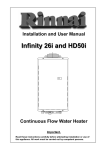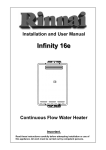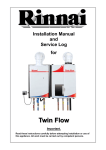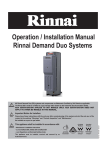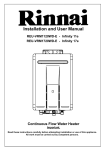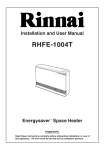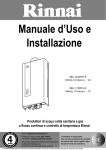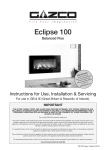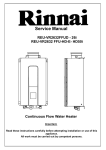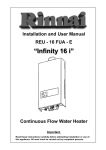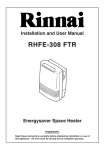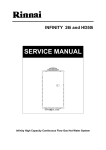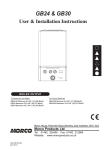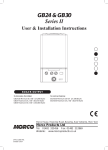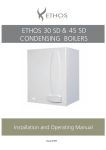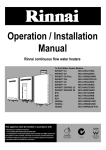Download Rinnai HDC1500e Installation Manual in PDF format
Transcript
Installation and User Manual REU-KM3237FFUD-E Infinity Condensing 32i REU-KM3237WD-E Infinity Condensing 32e REU-KM3237FFUDHD-E Infinity HDC 1500i REU-KM3237WDHD-E Infinity HDC 1500e Continuous Flow Water Heater Important. Read these instructions carefully before attempting installation or use of this appliance. All work must be carried out by competent persons. The Rinnai Infinity range of water heaters, when correctly installed, comply with the requirements of the United Kingdom Water Regulations / Byelaws (Scotland). These Products can be found listed in the Water Fittings and Materials Directory. The Rinnai Infinity condensing 32i and condensing 32e water heaters are CE Marked as allowed by Technigas. Certificate number: ID number: Date of Issue Quality System Standard ISO 9001 - 2000 The Design, Development, and Manufacture of Gas Water Heating Appliances done under Rinnai’s Quality Management System is certified under the Quality Management System Standard ISO 9001. Registration Number JQ0003D Registered since: February 1994 Certified by JIA—QA Center. 2 CONTENTS Contents………………………………………………………………..…………………3 User Instructions.....................................................................................................4 Features and Benefits………………………………………………..………….5 Important Information…………………………………………...……..………..6 Operation without Remotes……………………………………………….……8 Status Monitor..............................................................................................8 Temperature Controls…………………………………………….…………..…9 Error Messages…………………………………………………………………14 Restarting the Rinnai Water Heater………………………………………….16 Caring for the Infinity……...……………………………………………………16 Installation Instructions…………………………………………….………..…………17 UK Installation Instructions…………………………………………………….18 Unpacking Rinnai Water Heater…………………………….………………...19 Operation ..............……………………………………………...……………...20 Main Components………………………………………………..……………..22 Installation Instructions……………………………………………….………...23 Flue Requirements……………………...…….………………………………..28 Condensate Disposal…………………………………………………………...31 Temperature Controls…………………………………………………………..33 EZ Connect.................................................................................................35 Testing…………………………………………………………………......…….36 Gas Pressure Setting…………………………………………………….....….37 Dip Switch Setting………............……………………………………………...39 Dimensions…………………………...........................………………………..41 Technical Details..……………………………………............………………...42 Flow Chart…….………………………………………………......………..……43 Wiring Diagram…….……………………………………………………………44 Diagnostic Points…………………………………………………………….....45 Water Flow Characteristics.........................................................................46 Letter of Compliance……………………………………………………....…...47 CE Certificate……………………………..……………………………………..48 Commissioning Checklist…………………...………………………………….49 UK Warranty………………………………….………………………………….50 Specification................................................................................................52 Contact........................................................................................................53 Heater Details.............................................................................................53 3 USERS INSTRUCTIONS The following instructions are designed for the user of the water heater. The user may not install or adjust the appliance in any way that requires the removal of the front cover of the unit. To remove the front cover of the unit you must be certified competent to do so. Information for the Installer is given on page 17. All work done on this appliance must be done by a qualified gas engineer. A qualified gas engineer must carry an up to date CORGI Registered Gas Installer photo identification card while working on gas appliances. If you are unsure do not be afraid to ask the engineer to show you the card. If you are still not satisfied call CORGI on 0870 401 2300 and verify the engineer’s name with their database. This is for your own safety. Responsibilities of the USER The user must abide by all warnings given in this book. The user must only reference the user section of the book, and may not carry out any procedure listed in the installer section. This installation manual should be kept with the appliance for maintenance and user information. The user must have the unit checked and maintained annually by a gas engineer. The user must periodically check the water filter on the inlet to the appliance. The user must not use the appliance in any way that it was not meant to be used. The user may only use the heater as detailed in the User portion of this manual. Interference with a sealed component is not permitted Conversion to other gas types should only be carried out by a qualified installer or a gas distributor according to the practice in the country where the unit is installed. The user must not store or use any flammable vapours or liquids in the vicinity of this or any other appliance. The user should familiarise themselves with the water heaters gas service valve and the main gas valve to the premises. IF YOU SMELL GAS Isolate the gas supply and get out of the building. Do not try to light any appliance. Do not turn any light or other electrical switch on or off. Do not use any telephone in the building. Call your gas engineer from a safe location and follow their instructions. If you cannot reach your gas engineer ring the following: National Grid 0800 111 999 4 FEATURES AND BENEFITS Congratulations on purchasing the Technologically Advanced, Temperature Controlled, Rinnai Hot Water System. x Rinnai water heaters will NEVER RUN OUT of hot water. As long as electricity, water, and gas supplies are connected, hot water is available when hot water taps are open. x Built into the main micro-processor is the facility to LIMIT THE MAXIMUM TEMPERATURE of the hot water supplied. The water temperature may be set to various temperatures. This is particularly useful when the hot water unit is installed where young children or the infirm may be using the hot water. If required, the temperature can be changed via the dip switches on the PCB or with a localised controller. For further information, please contact Rinnai. x Rinnai Infinity water heaters are powered flue appliances. This makes them COMPACT, saving both floor and wall space. x The temperature of outgoing hot water is CONSTANTLY MONITORED by a BUILT- IN SENSOR. If the temperature of the outgoing hot water rises to more than 3°C above the selected temperature the burner is shut OFF and only turned ON again when the temperature falls to below the selected temperature. x The burner lights automatically when the hot water tap is opened, and extinguishes when the tap is closed. IGNITION IS ELECTRONIC, so there is no pilot light. When the hot water tap is off, no gas is used. x The Infinity Condensing 32i / HDC1500i and Condensing 32e / HDC1500e have a built in Status Monitor on the front of the unit to display error codes and run condition. Up to four external temperature controllers can be mounted remotely from the heater. This offers the following additional features: Localised temperature setting. Diagnostic information. Error Codes. Clock Bath fill x ‘Deluxe’ Temperature Controllers are an optional extra. These provide functions including Bath Fill, Voice Prompt, and Clock Setting. x Temperatures selected at the controllers are retained in the SYSTEM MEMORY x Operating NOISE LEVEL IS VERY LOW. x ERROR MESSAGES ARE DISPLAYED on the Temperature Controllers, assisting with service. x FROST PROTECTION device built in as standard. 5 IMPORTANT INFORMATION Excessively hot water is dangerous, especially for young children and the infirm. The water heater allows you to control the temperature of your hot water to safe levels. Water temperature over 50ºC can cause severe burns instantly or even death from scalding. Children, disabled and the elderly are at the highest risk of being scalded by excessively hot water. Always test the temperature of the water before bathing or showering. Burns from hot water taps can result in very severe injuries to young children. Hot water at 65°C can severely burn a child in less than half a second. At 50°C it takes five minutes. Burns can occur when children are exposed directly to hot water or when they are placed into a bath which is too hot. Do stay with children whenever they are in the bathroom. x Consider child—resistant taps or inexpensive tap covers, both of which prevent a child’s hand from turning on the tap. Do take them out of the bathroom if you need to answer the phone or door. Do test the temperature of the water with your elbow before placing your child in the bath. DO x Consider reducing the Do make sure that the tap is turned off tightly. Do consider setting your Rinnai Water Heater at a maximum temperature of 50°C. Do install a child proof tap cover OR, Do install a child resistant tap. DO NOT Do not leave a toddler in the care of another small child. The older child may not have safely set the temperature. 6 temperature of the water supplied to the hot tap to 50°C. This approach can be extremely valuable because it requires a one time action for a long term reduction in risks of scalds. This type of automatic protection is important during times when a parent or carer has been distracted. IMPORTANT INFORMATION Always check water temperature before use. Hot water may go cold without warning at very low water flows (less than 3 l/min.) OFF! Refer to warning about hot water on page 6 for important safety information. The delivered water temperature is controlled automatically. The water from the hot tap may be reduced after the temperature shown on the remote control is raised. The water flow may also vary with the temperature of the incoming water supply. 43°C If freezing temperatures are expected, turn off the water and gas, and drain the water heater. Turn Water Off Filter 55°C Drain Gas Valve Turn Gas Off Drain Water Hot Cold Gas If the power is left on the Automatic Frost Protection will prevent the unit from Freezing. Frost protection is standard on all units. Keep flammable materials, trees, shrubs, chemicals, etc. away from the flue outlet / terminal. Do not touch the flue outlet. Do not insert objects into the flue outlet / terminal. HOT! On cold days steam may be discharged from the flue outlet. This is normal, do not be alarmed. It does not indicate a fault. Do not spray water into flue terminal 7 OPERATION WITHOUT REMOTES Rinnai Infinity products have no pilot light and operate automatically as soon as water flow is sensed. The burner ignites with electronic ignition and the flame extinguishes as soon as water flowing through the appliance stops. Turn On by opening the hot water tap OFF! HOT NOTE ON! COLD OFF! COLD ON! HOT The Rinnai Infinity range of water heaters are factory preset to a temperature of 55°C; the HD range are preset to 65°C. Other limits, lower or higher, are available on request. Temperature controllers are available to allow precise digital temperature control. Controllers can be installed at any time after installation of the hot water unit. Excessively hot water is dangerous. Rinnai water heaters allow you to control the temperature of your hot water to a safe level. Water temperatures above 50°C can cause severe burns instantly, such scalding may even result in death. Those most at risk are children, CAUTION disabled, elderly and the infirm. Hot water at 65°C (a very common water temperature in the UK) can severely burn a child in less than half a second. At 50°C it takes five minutes. Consider using Thermostatic Mixing Valves on the Hot Water Outlets. STATUS MONITOR The new series of Rinnai Water Heaters have a built in status monitor on the front. STATUS MONITOR The status monitor has three conditions: 1 - The water heater is off (no water flowing): the monitor is blank. 2 - The water heater is on (heating water): The monitor displays the set temperature. 3 - The water heater should be on, but is not (water is flowing, heater is not on): The monitor will display a flashing error code. NEW FEATURE 8 TEMPERATURE CONTROLS The purpose of a Temperature Controller is to enable the user to have localised control over the hot water supply. Used correctly, the hot water unit will supply hot water at the temperature selected, even when the water flow is varied, or when more than one tap is used. Adjustments to the operation of your hot water unit can be made with any of the Temperature Controllers. Each Temperature Controller can be individually programmed. Up to four Universal and/or Deluxe Temperature Controllers can be fitted with Rinnai water heaters. Universal Controllers allow temperature selection only and one comes as standard with the water heaters. Deluxe Temperature Controllers are an optional extra. These controllers have temperature selection, bath fill, voice prompt, and time clock functions. When more than one Universal Controller is used one may be set as the Master Controller to allow temperatures above 50°C. Various water temperatures (°C) can be selected as follows: Universal Controller: 37, 38, 39, 40, 41, 42, 43, 44, 45, 46, 48, 500C Master Universal Controller: 37, 38, 39, 40, 41, 42, 43, 44, 45, 46, 48, 50, 55°C ( 60, 65°C HD ) Deluxe Bathroom Controller: Hot Water Delivery: 37, 38, 39, 40, 41, 42, 43, 44, 45, 46, 48, 50°C Bath fill Delivery: 37, 38, 39, 40, 41, 42, 43, 44, 45, 46, 47, 48°C Deluxe Kitchen Controller: 37, 38, 39, 40, 41, 42, 43, 44, 45, 46, 48, 50, 55°C ( 60, 65°C HD ) If a temperature of 43°C or higher is selected on any controller and this temperature is then decreased to below 43°C and increased again whilst the water is running, the maximum selectable temperature will be 43°C. This provides additional safety for the user. Suggested temperatures are: Kitchen 50°C - 65°C*; Shower 39°C - 43°C; Bath fill 39°C - 45°C * This temperature may not be available on all installations. These temperatures are suggested starting points for selection. You may find higher or lower temperatures are more comfortable. Maintaining lower temperatures helps to save energy. To obtain water temperatures lower than 37°C simply add cold water. When multiple temperature controllers are used they allow the temperature to be set from various locations by pushing the transfer button which gives that controller priority over the system. The temperature selected by the controller with priority will be available to all outlets. 9 TEMPERATURE CONTROLS - OPERATING Remote temperature controllers provide control over the water temperature. Rinnai water heaters can be operated with 1, 2, 3, 4 or no temperature controllers. NOTE Each time a button is pressed, a BEEP will sound. The BEEP sound can be muted by depressing the Temperature Controller Up and Down buttons simultaneously for more than 3 seconds. This can be done for each Temperature Controller. To return to original settings, repeat this step. The temperature of the outgoing water is constantly monitored by a built in sensor. Safety features Whilst the hot water tap is open, the following safety features apply: x Temperature selection cannot NOTE If the temperature of the outgoing hot water rises to more than 3ºC above the selected temperature shown on the digital display, or the preset limit if controllers are not fitted, the burner will automatically go out. be transferred. x The temperature setpoint on the controller with priority can always be lowered, but the setpoint can only be raised to 43°C. The red operation indicator will also go out. x Other controllers are unable to take priority or change the temperature of the water. delivery The burner will ignite again once the outgoing hot water temperature falls to that shown on the digital display (or the pre-set limit of the Rinnai Infinity heater). x If off, the controller cannot be turned on. 10 TEMPERATURE CONTROLS - OPERATING Using the Temperature Controllers Adjusting Temperature Press the ON/OFF button on a temperature controller after making sure that water is not flowing. Simply press the Hot Water Temperature Up or Down arrow button until the desired temperature is displayed on the digital display. The system will become active, the temperature will default to 40°C and the controller that turned the system on will have priority. HOTTER COOLER The temperature setting on the controller will light up. Using Hot Water To turn off your hot water system To operate the heater, simply turn any hot water tap on. This will automatically light the burner providing hot water. The red IN USE indicator will glow on the temperature controller. During normal operation the system is left on. ON! To turn the system off simply press the ON/OFF button on any temperature controller (where fitted). This will shut the water heater down completely including the temperature controller digital display. COLD The Digital Monitor will go out. If hot water taps are opened when the Rinnai Infinity is off, cold water will flow from the taps. If the system is to be left off over the winter be sure to drain it down if there is a possibility of freezing temperatures. HOT Using High Temperature Display Controllers You will need to program the Master controller if you want to display and use temperatures over 50°C. Programming only needs to be done on Master universal controller; other universal controllers will not allow this. Deluxe Kitchen controllers are supplied already programmed to allow high temperatures. STEP 1: On the Master controller only press and hold the Transfer and On/Off buttons simultaneously (see fig 1.) until a “beep” is heard (approx. 5 seconds) Fig 1. STEP 2: When the Primary controller is switched on it should be possible to select temperatures higher than 50ºC. If not repeat STEP 1. If the master controller is replaced, repeat STEP 1 above for the new controller. NOTE 11 TEMPERATURE CONTROLS - OPERATING Using 2 or more Universal Temperature Controllers. Switching the system ON. The hot water system and all controllers can be switched ON and OFF from any controller by pressing the On/Off button as shown. When the system is turned ON the water temperature display will be lit. During normal operation the system is left ON. Do not push the On/Off button when water is running. Using hot water. Ensure the system is switched On by verifying the temperature display is lit. Ensure the local controller has priority by verifying the Transfer LED indicator is lit. If it is not then press the Transfer button once. This gives the local controller priority of temperature over the system. Select the desired temperature using the Hot water temp. buttons. The selected temperature will be displayed on all controller displays. This is the water temperature which will be supplied from the heater. Bathroom temperatures should be no more than 50°C. ON! COLD Open the hot water tap. The appliance will be activated and the In Use indicator will be lit. HOT Using 4 Universal Temperature Controllers. You will need to activate the fourth controller. STEP 1: On the Master controller press and hold the Transfer and On/Off buttons simultaneously (see fig 2.) until a “beep” is heard (approx. 5 seconds) Fig 1. STEP 2: Check that the display on all Four controllers is lit and displaying a temperature when switched on. If any ONE of the controllers displays two dashes (see fig 1.) in the display repeat STEP 1. If the master controller is replaced, repeat STEP 1 above for the new controller. NOTE Fig 2. 12 TEMPERATURE CONTROLS - INFORMATION Do not push the ON/OFF button on the Master controller after transferring priority of temperature selection to a Secondary controller as the system will shut down. Temperature priority cannot be switched to another controller when the water is flowing through the water heater. X Controller 1 in use Do Not Turn OFF the Master Controller If a temperature over 50°C has been selected on a controller and priority of temperature selection is transferred to another controller, then back again, the temperature on the controller will automatically drop to 50ºC. If the set point is 50°C or less it will not alter. This is a safety feature. Controller 2 cannot take priority Bathroom Kitchen Depending on the weather conditions and the length of the pipe between the heater and the tap in use, there may be a variation between the temperature displayed at the controller and the temperature at the tap. Kitchen Do not clean the control with solvents or detergents. Use only a soft damp cloth. 49°C S O L V E N T 50°C 13 ERROR MESSAGES Rinnai water heaters have the ability to check their own operation continuously. If a fault occurs, an error code will flash on the Digital Display (and on the Status Monitor) if you have temperature controllers installed. This assists with diagnosing the fault, and may enable you to overcome a problem without a service call. Please quote the code displayed when enquiring about service. Code Displayed Fault - Noticeable reduction in water flow 03 Power interruption during operation (water will not flow when power returned) Turn off all hot water taps and circulating pumps. Press ‘On/Off’ twice 10 Not enough combustion air Check for physical blockages around air intake or exhaust. Check combustion fan. 11 No Ignition / Gas supply Check gas valves, gas supply and sparker unit. 12 Flame failure / Earth Leakage Check gas valves and gas supply. Check flame rod. Check earth wire lead. Check remote control. 14 High flame safety device Service Call 16 Over temperature warning Service Call 25 Condensate pipe blockage Check for blockage on condensate drain path. 32 Outgoing water temperature sensor faulty Service Call 33 Heat exchanger outlet sensor faulty Service Call 52 Gas modulating valve faulty Service Call 61 Combustion fan failure Service Call 65 Water flow control faulty (does not stop flow properly) Service Call 71 Micro-processor failure Service Call 72 Flame rod circuit error Service Call LC (00)*** Scale build-up in heat exchanger Service Call Remedy Inlet water filter needs to be cleaned. * In all cases, you may be able to clear the Error code by turning the hot water tap OFF, then ON again. If this does not clear the error, try pushing the On/Off button OFF then ON again. If the Error Code still remains contact Rinnai or your nearest service agent for advice. ** Faults caused by insufficient gas/water supply or gas/water quality and installation errors are not covered by the manufacturer’s warranty. *** The display will alternate between temperature setting and LC code. The controller will continue to beep. The LC code will reset if power is turned Off and then On. 14 ERROR MESSAGES Troubleshooting without controllers If you have not installed temperature controllers and experience the following symptoms, please carry out the suggestions below. If symptoms continue, please contact Rinnai for advice. Fault Remedy Heater does not attempt Check the power is on at the heater. to start at all. Check the cold water valve supplying the heater is open. Heater starts then shuts down immediately. Check the power is on. Check the gas valve at the heater and at the gas meter is fully open. Open the hot water tap fully. Heater starts then the water goes cold. Check the power is on. Open your hot water tap further or try another hot outlet. NOTE: Faults caused by insufficient gas/water supply or gas/water quality and installation errors are not covered by the manufacturer’s warranty. Installations with circulation pumps With temperature controller fitted. If you have an installation using a secondary circulation pump this must be switched off so that there is no flow through the heater when starting or after a power failure. If the pump is running the unit will not operate (no display on the controller). Isolate pump then start heater before restarting pump. This is a safety feature. The pump should also be fitted with a timer to prevent the consumption of energy while the building is not used. The timer should bring the system back on at least one hour before it is to be used. Without temperature controller fitted. The heater should automatically reset and provide water at the temperature set by the internal limit switches. 15 RESTARTING THE RINNAI WATER HEATER The heaters should be restarted in this manner. Standard system. Single or multiple water heaters without remote controllers. The heaters will automatically reset without any user involvement. Single or multiple water heaters with remote controllers. The heaters will be required to be switched on using the ON/OFF button on a remote controller. Ensure that all taps/water outlets are closed and no water is flowing through heaters. Hot water system incorporating secondary recirculation pump. Single or multiple water heaters without remote controllers. The heater(s) will automatically reset without any user involvement. Single or multiple water heater(s) with remote controller(s). To reset the heaters follow the steps. 1. Turn off all hot water taps. 2. Turn off supply to secondary circulating pump or alternatively, isolate pump flow. 3. Turn on heater at remote control. 4. Select required temperature. 5. Switch on supply to secondary circulating pump or open valve on pump flow. The heater will now be ready to supply water at the set temperature. If following the above procedure does not reset the heater switch it on and off at its main supply, and then go through these steps again. If heater is still not working call your local service agent or Rinnai for assistance. CARING FOR THE INFINITY Maintenance Even if there does not seem to be a problem with the water heater it is required in the UK that all gas appliances are serviced every year by a certified gas engineer. This is to ensure continued safety of the gas appliance. If you need a recommended service engineer contact Rinnai or your supplier. Care When the appliance casing, operation panel, and remote controls surfaces become dirty gently wipe them clean with a soft, damp cloth. Do not use detergents on these parts. Filter The water heater has a filter on the cold water inlet connection. This filter will need to be cleaned occasionally. How often will be determined by the local water conditions. The water filter can be located on the diagram on page 20. Isolate the cold water inlet and hot water outlet with the valves near the heater. Release the pressure in the heater by unscrewing the drain valve (shown on page 20.) Then remove the filter, clean it and replace it. 16 INSTALLATION INSTRUCTIONS STOP To go beyond this point in the manual you must be a registered gas engineer. Do not attempt to install this appliance if you are not qualified. This can void the warranty. If the information in this manual is not followed exactly a fire or explosion could result. This manual must be read in its entirety before installing the appliance. If you are unsure of any point contact Rinnai or your supplier. 17 UK INSTALLATION INSTRUCTIONS IMPORTANT INFORMATION This appliance may only be installed by someone certified competent to do so. At the time of printing the only people deemed competent to install this appliance are those that are CORGI registered for this type of appliance in this type of location who have a current ACS certificate. 1. Gas safety (Installation & Use) regulations 1998 are the ‘Rules in force’. In your own interest and that of safety, it is law that all gas appliances are installed by competent persons in accordance with the above regulations. Failure to install appliances correctly could lead to prosecution. Other persons should NOT attempt to install this equipment. 2. Building Regulations G3 require installers of unvented systems to be competent to do so. Competence can be shown by holding a current certificate in Unvented Domestic Hot Water Systems. If the Infinity is installed in a flow and return, or tank system, or any other closed system then the system is unvented. 3. Installation must be carried out in accordance with the current issue of the following: Building Regulations issued by the Department of the Environment Building Standards (Scotland) Regulations. I.E.E. Wiring regulations for electrical installations. Gas safety (Installation and Use) Regulations current issue. BS 5546 BS 5440 BS 6891 BS 5482 BS 6700 BS 6644 Institute of Gas Engineers Publications Local byelaws Water regulations Health and safety at work etc. Act 1974 IGE/UP/10 Part1 Edition 2. Building Regulation J and G Such other specifications and regulations that may supersede or complement the above documents. It is the installer’s responsibility to ensure that the unit has been installed to all current requirements. Please be sure that you are fully aware of your obligations and responsibilities under these regulations. 18 UNPACKING RINNAI WATER HEATER x After unpacking the appliance check for damage, if the heater is damaged contact your supplier immediately. Do not install a damaged appliance before checking with your supplier. x A heater accessories pack is inside the carton. One remote control is supplied with the Infinity range of water heaters. Remote controllers are not supplied with the Rinnai HD range of heaters because they are commercial units. If you require controllers in commercial situations they are compatible with the HD range and available from Rinnai UK or your supplier. x Check that the appliance supplied is the correct gas type and pressure for the installation. Refer to the data plate located on the left-hand side of the appliance. x Remove the heater and the accessories from the carton, and check that all the parts are included. The remote control cable is provided with spade connectors. 19 OPERATION - SCHEMATIC Infinity Condensing 32i and HDC1500i Infinity Condensing 32e and HDC1500e 20 OPERATION - PRINCIPLE HOT WATER SUPPLY OPERATION Ignition Press ON/OFF Button of Remote Controller to turn on unit and the remote controller display and priority LED will light up. When a hot water tap is opened the Water Flow Sensor revolves and sends a pulse signal to the Printed Circuit Board (PCB.) When the PCB detects water flow it compares the measured temperature to the temperature setpoint If required it begins the ignition process with the Combustion Fan Motor starting first. Once the air proving is made the Main Solenoid Valve and Change-over Solenoid Valves are opened and the Burner is lit by the sparking Igniter. Temperature Control Once the Flame Rod proves ignition the Infinity modulates by controlling the gas rate, combustion air, and water flow to precisely heat the water. This control is done by measuring the outgoing water temperature with a Thermistor. Standby When the hot water tap is closed the PCB no longer receives a pulse signal from the Water Flow Sensor. The PCB shuts the Main Solenoid Valve and Change-over Solenoid Valves and the Burner extinguishes. 21 MAIN COMPONENTS 1. Gas Control Unit 1.1 Modulating Valve This device is used by the PCB to adjust the volume of gas to the burner in proportion to the volumetric flow rate of water in order to maintain a supply of constant temperature hot water amid changes in water flow rates and incoming temperatures. 1.2 Change-over Solenoid Valves Additional solenoid valves are included to section the burner and stage the control in 6 steps. This gives the Burner more steady combustion at the required capacity and allows the water heater to operate at very low flow rates and temperature rises. 2. Flame Rod Monitors combustion characteristics inside the combustion chamber. If the flame fails, gas supply is stopped. Works through rectification of the combustion flame. An AC voltage is supplied to the flame rod. Electrons can only pass from the rod to the earthed burner through the flame, and never from the burner to the rod, so the resultant DC current is used to prove combustion. When the DC current is present the burner has normal combustion, if the DC current is not present (or an AC current is present) the unit shuts the solenoid valve. 3. Thermal Fuse The thermal fuse is an electric link which must be intact for the unit to operate. If the thermal fuse reaches a set temperature it will melt and the unit will shut down. The thermal fuse must be replaced if it melts. It is to protect against overheating and heat exchanger splits where water may leak out and be superheated into steam. 4. Overheat Safety (Bi-metal Switch) This Bi-metal Switch is fixed at the inlet bend of the Heat Exchangers final pass. If the temperature outlet from the heat exchanger reaches 97°C the bi-metal switch will open and the solenoid valve circuit is broken. This will cease combustion in case of overheat. 5. Combustion Fan The combustion fan supplies primary air into the burner wings and secondary air up through the Bunsen style burners. The fan is DC low voltage and the speed is controlled by the PCB depending on the hot water supply and temperature. The fan speed is compared to the current required to attain that speed for air proving. If the fan current is over or under the parameters for the given speed the unit will shut down on air proving. 6. Water Flow and Bypass Servos with Water Flow Sensor 6.1 Water Flow Sensor Water flow sensing is done with a small turbine that spins when water travels through it in the correct direction. Each of the four fins on the turbine has a small magnet on it. Outside of the valve there is a magnetic sensor that detects the speed that the turbine is revolving. The revolution speed is input to the PCB which relates this speed to the water flow volume and determines whether it is sufficient for ignition. 6.2 Water Volume Flow and Bypass Servo Water flow control is achieved through the use of servo driven water flow and bypass valves. Both servo motors are controlled by the PCB. The ‘Water Flow Valve’ restricts the flow of water into the heat exchanger assembly if the programmed temperature cannot be achieved. This will limit the maximum hot water flow to 37 L/min, and will limit the water flow further when the burner is at high fire to ensure the temperature setpoint is met. During normal operation at low (less than 60°C) setpoint, cold water from the inlet valve is mixed with hot water from the heat exchanger outlet. The ‘Bypass Valve’ mixes the correct proportion of cold and hot water to ensure accurate hot water delivery temperature over the available range of flow rates. For temperature setpoint over 60°C the bypass servo will be shut. The water flow and bypass valves are a combined assembly on the cold water inlet of the appliance. 22 INSTALLATION INSTRUCTIONS - POSITIONING External Models The new Infinity Condensing 32e / HDC1500e is designed for ‘Outdoor’ Installation only. As such, it must be located in an above ground, open air situation with natural ventilation, without stagnant areas, where products of combustion are rapidly dispersed by wind and natural convection. The exhaust slot on the front should follow the same location guidelines as a balanced flue terminal. Ensure that the flue terminal and hot water outlet connection cannot be touched by children. The exhaust slot must be clear of obstructions and shrubbery. Internal Models The Infinity Condensing 32i / HDC1500i is designed for ‘Indoor’ installation only. It may be installed ‘Outdoors’ in an enclosure if the requirements are satisfied. An enclosure is defined as a compartment, enclosed area or partitioned off space primarily used for the installing of the appliance. If installed in an enclosure, either Internally or Externally, the location should be ventilated and provision must be made for the safe disposal of any leaking water to an exposed location. When positioning appliance the flue terminal clearances must be in accordance with local requirements. Consideration should be given to other appliances, openings, and boundaries. Multiple heater installations can be installed with the heaters manifolded together. The minimum distance required between the heaters may then be based on the necessary clearances between flue terminals. The internal units Infinity may not be installed in a humid area. All Models LPG appliances may not be installed in basements or below ground level. The wall or structure on which the heater is mounted must be capable of supporting the weight of the appliance (listed on page 52) and associated pipework. The heater must be installed in a vertical position with the gas and water connections on the underside pointing downward. Ensure that suitable screws or bolts are used to secure the water heater to the wall. Bracket and fixing hole locations are shown on the template included. The top bracket has a keyhole slot so that the appliance can be hung on one screw, and then the other fixings can be added to secure the unit. The appliance should be placed as close as practical to the most frequently used hot water outlet point or points to minimise the delay time for hot water delivery. For installations where the distance between the unit and hot water outlet points is considerable, the appliance can also be fitted in a 'flow and return system' which minimises the waiting time for hot water delivery. Alternatively, multiple appliances can be strategically placed to service outlet points with minimal delay time. Contact Rinnai or your supplier for further information. THIS APPLIANCE MUST NOT BE USED AS A DOMESTIC SPA OR SWIMMING POOL HEATER. Please consider the location of the appliance and what is below it. As with any water fitting there is a possibility that a connection or component could develop a leak over time; or water may spill during servicing of the appliance. Rinnai can not be held responsible for any consequential water damage so it may be necessary to fit a drain pan under the unit. 23 INSTALLATION INSTRUCTIONS - CONNECTIONS Clearance The appliance must be in an accessible location. Sufficient clearances shall allow access to, and removal of, all serviceable components. The following clearances should be followed. From Combustibles From Non-Combustibles Cond.32i/HDC1500i Cond.32e/HDC1500e Cond.32i/HDC1500i Cond.32e/HDC1500e Above 300 300 50 50 Behind 0 0 0 0 In Front 600 600 600 600 Sides 50 150 15 15 Below 300 300 50 50 Flue pipe 0 - 0 - Water Supply. Where the water supply pressure exceeds 10 bar, an approved pressure reducing device must be fit at the inlet of the appliance. To achieve the maximum rated flow a minimum water supply pressure of 2.2 bar is required at the appliance inlet. The unit will operate at lower supply pressures but the maximum flow rate will not be achieved. Most installations will use high temperature setpoints which will reduce the available flow rate and heat exchanger pressure drop, and therefore less pressure will be required at the inlet. See the pressure chart on page 46. Contact Rinnai or your supplier for 'gravity fed' or 'low pressure' hot water installations. Water pipe sizing and layout should be designed correctly to ensure the given water flows from the appliance are available. All hot water pipework should be insulated to optimise maximum performance and energy efficiency. Water Connection. Connect the hot and cold water supply pipes as shown on page 26. An approved isolation valve and strainer MUST be installed in the cold water inlet pipe. An approved isolation valve and draining point should be installed in the hot water outlet pipe. There must be a union or release fitting on the heater side of the isolation valves. An unvented kit to local regulations must be installed in the pipework when the system is closed (i.e. has a flow and return, or tank.). Positions of the cold water inlet, hot water outlet and gas connections are shown on page 41. If the heater is in a hard water area a suitable water conditioning device must be installed to prevent the build up of limescale within the heat exchanger. Heat exchangers damaged by scaling are not covered by the manufacturer’s warranty. Description pH Maximum Recommended Levels 6.5 - 9.0 Total Dissolved Total Hardness Solids (TDS) 600 mg/litre 150 mg/litre Chlorides Magnesium Calcium Sodium Iron 300 mg/litre 10 mg/litre 20 mg/litre 150 mg/litre 1 mg/litre Gas Connection Check pipe sizing required for the heater input. The heat input for the water heater is shown on page 42. The size of the gas meter (or regulator) and pipework must be sufficient for all appliances on the main. Sufficient gas must be available at the appliance if correct operation is to be expected; insufficient gas will damage the unit. An approved gas isolation valve must be fitted at the gas inlet. A union or release fitting should be installed after the isolation valve. Electrical Connection The appliance must be earthed. The appliance is suitable for 230VAC – 50Hz mains only and all wiring must be carried out to local regulations. 24 UK INST. INSTRUCTIONS - CONNECTIONS Water Connection. For all closed systems (with flow and return or tank) the system must incorporate an unvented kit with the components shown below. The safety relieve valve must discharge safely into a suitable drain via a tundish. Expansion Vessel Safety Relief Valve Mains Isolation Y- Strainer Pressure Valve Reducing Valve with Gauge Double Check Valve Tundish Gas Connection Refer to BS6891 (Natural Gas) and BS5482 (Propane) for guidance on correct pipe sizing calculation. There must be 20 mbar Natural Gas (G20) or 34.5 mbar Propane (G31) at the inlet of the appliance with all appliances at high fire. Electrical Connection The heater electrical supply must be installed to the latest I.E.E. regulations. If the unit is hard wired (moulded plug removed) it must be provided with a fused (5A) local isolator with a contact separation of 3mm minimum on all poles for servicing. Observe polarity and ensure that wiring is correctly restrained. 25 INSTALLATION INSTRUCTIONS - SCHEMATICS Single Infinity Direct Flow Direct feed to the hot water outlets. Mains is fed directly into the unit. Use a strainer, but a check valve is not required. Standard domestic or small commercial set up. Used with controllers to alter the temperature at the point of use (only using hot tap) or temperature set on the dip switches for the maximum needed at any outlet, and mixed down by TMVs or manual tempering valves. This information is intended as a guide only, it does not imply compliance with water or gas installation regulations. Components will vary depending on the actual installation. Check local regulations before installation. Draining Point Manifolded Infinity x 2 With Pumped Secondary. Circulation system used in commercial situations where the heaters are not close to the outlets. Ensures hot water is available at the outlets quickly, without a lot of wastage. Mains is fed to the unit via a header pipe that branches off to each heater. The secondary return is Tee’ed in to the heater’s supply. A complete unvented kit is required as it is a closed system. Requires nrv after pump. PAM valve or EZ Connect needed to sequence water heaters. Hot Water Pump Temperature is set on the dip switches for the required circulation. 60°C for most applications. Gas Cold Water Return Water This information is intended as a guide only, it does not imply compliance with water or gas installation regulations. Components will vary depending on the actual installation. Check local regulations before installation. Draining Point Valve 26 Pressure Reducing Strainer Valve NonReturn Safety Valve Valve Expansion Vessel Flow Modulation Valve UK INST. INSTRUCTIONS - VENTILATION General Information on the internal range of water heaters. The Rinnai Infinity internal water heaters are room sealed appliances. Ventilation requirements of BS 5440 allow room sealed appliances to be installed in spaces and rooms, including bedrooms, without ventilation. If a Rinnai Infinity internal water heater is installed in a compartment it must have the following amount of permanent ventilation. Ventilation from compartment to room: 560 cm2 at high level AND 560 cm2 at low level Based on 10cm2/kW net heat input Ventilation from compartment directly to outside: 280 cm2 at high level AND 280 cm2 at low level Based on 5 cm2/kW net heat input The area given is the free area of the vent or equivalent free area for ventilators of more complex design. Any space taken up by grille louvers should be subtracted from the total area to find the free area of the vent. For two heaters the area should be doubled, for three tripled, and so on. Windows and doors can not be considered ventilation unless they are permanently fixed in the open position. Please refer to IGE/UP/10 Part 1. Edition 2 page 17 for further information or contact Rinnai UK. 27 FLUE REQUIREMENTS - INSTALLATION The flue must be installed by a competent, authorised person. It is the installer’s responsibility to ensure that the unit has been installed to all current local requirements. Ensure that the flue terminal and hot water outlet connection cannot be touched by children. The flue must be clear of obstructions and shrubbery. Concentric Flues The Rinnai Infinity Condensing 32i and HDC1500i are internal units which may only be installed with the approved Rinnai Infinity and HD flue kit provided. These instructions only apply to coaxial Rinnai Flues. If in doubt contact Rinnai UK. The required clearance of the flue terminal is shown on page 30. When multiple units are installed together there must be enough of a gap to satisfy the requirements of the regulations. Under current regulations the heaters should have at least a 100mm gap between them. The flue terminal should be over 2m from ground level whenever possible. For lower installations a terminal guard cage must be installed. Flue Length. Vertical Termination. If the flue is to terminate vertically the maximum flue length is 9m. At that length three bends 90° are permitted. For an additional 90° bend 2m must be subtracted from the maximum length (1m for each 45° bend). No more than four 90° bends are permitted. Horizontal Termination. The maximum flue total equivalent length is 15m. 2m must be subtracted from the total equivalent length for each 90° bend and 1m for each 45° bend. A maximum of four 90° bends can be used. Regard less off the total equivalent length the maximum height of the terminal above the water heater is 9m. Common Header (Cascade) Flues Do not connect this appliance into any common header flue, cascade system, or natural draught chimney. For information on these installations contact Rinnai. Separate instructions are provided with the flue detailing the installation of the flue parts. It is important that any condensate is kept away from the heat exchanger. The flue should tip away from the unit without a condensate trap, and towards the unit if there is a trap. Condensate kits are not required if the flue is directly through the wall behind the unit. For these installations the terminal should slope gently to the outside to prevent ingress of rain. Although no condensate is expected in flue runs this short a small amount may occur at start up on very cold days. Care should be given to the placement of the terminal to prevent risk from condensation. Condensation water can cause burns, and during winter could create a slip hazard. It is the responsibility of the installer to decide the best place for the terminal. Flue pipes must include a condensate drain if the total height exceeds 1.5m. There is a special condensate drain collector piece available through Rinnai UK. For flue runs requiring a drain the horizontal sections should slope towards the appliance, and the flue should be bracketed to prevent sagging. If the flue run is less than 1.5m it should slope gently to the outside to prevent ingress of rain. The drain pipe should be run in 22mm PVC, uPVC, or ABS pipe, copper is not recommended. The drain pipe MUST be trapped. 28 FLUE REQUIREMENTS - INSTALLATION For the Infinity Condensing 32i and the HDC1500i the flue system is considered part of the continuous flow water heater. The following flue type and make is approved in combination with above mentioned water heaters. Ubbink flue system 952-032-001 Infinity Condensing 32i / HD1500i Standard Horizontal Kit 952-032-002 Infinity Condensing 32i / HD1500i 45 deg Bend 952-032-003 Infinity Condensing 32i / HD1500i 90 deg Bend 952-032-006 Infinity Condensing 32i / HD1500i Flue Extension 1000mm 952-032-007 Infinity Condensing 32i / HD1500i Vertical Flue Kit 952-032-008 Infinity Condensing 32i / HD1500i Flat Roof Flashing 150 dia 952-032-011 Infinity Condensing 32i / HD1500i Lead Tile 25-45 deg 952-032-017 Infinity Condensing 32i / HD1500i Lead Tile 5 - 25 deg 952-032-022 Infinity Condensing 32i / HD1500i Horizontal Extension Kit 952-032-024 Infinity Condensing 32i / HD1500i Flue Extension Telescopic 330mm For terminations straight through the wall the special horizontal adapter for short flue lengths is used. Never use an extension as the first component, they will cause damage to the water heater and the flue system. Secure flue connections with pipe clamps or perforated hanger iron. Please see page 30 for recommended terminal positions. Warnings: Before installation inspect each flue component for damage and correct seal placement. Do not attempt to fix or install any damaged component. Improper installation of flue systems and components, or failure to follow all installation instructions can result in property damage or serious injury. The Rinnai Infinity Condensing 32i / HDC1500i is for internal installation in conjunction with the Rinnai flue system The flue must be installed in accordance with: Manufacturers Installation Instructions British Standards including BS5440 Gas Safety (Installation and Use) Regulations IGE/UP/10 Part1 Edition 2. Building Regulation J Such other specifications and regulations that may supersede or complement the above documents. The flue must be installed by a competent, authorised person. It is the installer’s responsibility to ensure that the unit has been installed to all current requirements. Location of the appliance flue terminal must be in accordance with the clearances shown in BS5440-1:2000. Table and Figure C.1 is provided for your guidance on page 30. When multiple room sealed forced draught terminals are installed together there must be enough of a gap to satisfy the requirements of the regulations. Under current regulations the terminals must have at least a 300mm gap between them. The flue terminal should be over 2m from ground level whenever possible. For lower installations a terminal guard must be installed. 29 UK FLUE REQUIREMENTS - POSITION Dimension Terminal Position Distance A Directly below an opening, air brick, opening windows, etc. 300mm B Above an opening, air brick , opening window, etc. 300mm C Horizontally to an opening, air brick , opening window, etc. 300mm D Below gutters, soil pipes or drain pipes. 75mm E Below eaves. 200mm F Below balconies or car port roof. 200mm G From a vertical drain pipe or soil pipe. 150mm H From an internal or external corner. 200mm I Above ground, roof or balcony level. 300mm J From a surface facing the terminal. 600mm K From a terminal facing a terminal 1200mm L From an opening in a car port. ( eg door, window) into a dwelling 1200mm M Vertically from a terminal on the same wall. 1500mm N Horizontally from a terminal on the same wall. 300mm O From the wall on which the terminal is mounted N/A P From a vertical structure on the roof. N/A Q Above an intersection with roof. N/A 30 CONDENSATE DISPOSAL The condensing unit generates condensate continuously at a rate of up to 5 litres per hour as a by-product of highly efficient gas burner system. This condensate must be drained via a pipe to a suitable point of discharge. Because the condensate is a by-product of a gas combustion it is mildly acid. For this reason copper tube and fittings MUST NOT be used as it will corrode. Instead, Rinnai recommend plastic pipes and fittings such as Unplasticised Polyvinyl Chloride (UPVC) or Polyethylene (PE) which is commonly used for irrigation piping. Important considerations for the Condensate Drain Pipe 31 CONDENSATE DISPOSAL 32 TEMPERATURE CONTROLS - INSTALLATION General Information Commercial installations do not generally have controllers installed. These installations usually have one permanent set temperature that is constant at all times. The public should not have access to alter the temperature in these situations. These installations do not require controllers as the temperature can be set by a series of dip switches on the PCB. Exceptions to this are the following: 1. Circumstances where the required temperature is not available with the dip switches (for example 41°C or 47°C.) 2. Circumstances where the temperature needs to be raised periodically by the building occupant in order to flush the system. 3. Domestic situations where the user needs control of the temperature of the water so that different temperatures can be used at different outlets. In situations such as 1 and 2 the controllers should be installed in places out of reach of the public, such as in the maintenance room or in a locked cupboard. NEW FEATURE This Commercial Setting will allow the controller to come back on automatically after a power cut at the temperature setpoint previous to the power cut, regardless of whether water is flowing through the unit . This should only be used for commercial installations. The maximum temperature available on the Primary Universal Remote Controller is the set point on the dip switches. If only one controller is installed it will not go beyond 50°C when first installed. To bypass this see page 11. Positioning the temperature controls, the following points should be taken into account: x Fit the controls out of reach of children (suggested height from the floor 1.5m.) x Avoid positions where the controllers will become hot. Do not fit them near stoves or ovens, or above radiators or heaters. x If possible, avoid exposure to direct sunlight or positions where bright lights will make the digital display difficult to read. x Position away from areas where the controller will be prone to splashing by cooking products such as oils and fats. x The temperature controllers are water resistant, however they should be positioned away from areas where direct or persistent splashing could occur. x Refer to the local electrical wiring regulations current edition for location requirements in shower and bath areas. x The cables to the temperature controller carry only 12VDC (extra low voltage.) x When using more than one temperature controller the signal cable should be run in parallel. Do not wire the controllers in series. The installation in every application will vary, therefore the temperature controller cable has been provided so that you may cut the length accordingly and fit the spade connectors, ensuring a good connection. Cables are simply ‘piggy-backed’ at the water heater or at the primary temperature controller. Polarity is not important when connecting the cables, either colour wire can be connected to either terminal at both the heater or primary temperature controller. If more cable is needed any cable with similar specification to the cable supplied with the controller can be used. Maximum length is 50 metres. 33 TEMPERATURE CONTROLS - INSTALLATION Universal Temperature Controller - MC-91 1. Determine the most suitable position for the temperature controller. 2. Drill 3 holes in the wall (fig.1), one for the cable and two for the securing screws. Fit wall plugs if needed and ensure controller is level. 3. Run the cable provided through the hole in the wall ensuring that the end fitted with the connector is nearest the controller (fig.2). 4. Remove the face plate from the controller using a flat screwdriver (fig.3). Take care not to damage the cover. 5. Connect the cable to the temperature controller. 6. Fix the controller to the wall and fasten with the Phillips head screws supplied as shown in (fig.4). 7. Remove the protective plastic film from the controller face. 8. Replace the face plate. Connecting One or Two Controllers 1. Isolate the electric power supply. 2. Remove the retaining screw of the quick cable connector door located at the base of the appliance (fig.5) 3. Thread the water controller cable through the weather seal of the cable access hole (A) (fig.6) in the direction shown allowing sufficient cable length so that the sheath of the cable can be secured with cable clamp (B) supplied with the water controllers (fig.7) 4. Loosen the screws on terminals (C) and (D). Connect the spade connectors of the controller cables to these terminals. Tighten the screws on terminals (C) and (D). Polarity is not important, either wire colour can be connected to either terminal (fig.8). 5. Return the quick cable connector door to the original position taking care not to damage controller wires and replace the retaining screw. Connecting Three Controllers Repeat steps 1, 2 and 3 above. x Cut the spade connectors from two of the controller cables to be connected to the appliance (4 spade connectors should be cut off) and discard. Connect the wires from these two cables and terminate into two new spade connectors as shown in fig.9. Spade connectors are supplied with the controllers. Repeat steps 4 and 5 above Connecting Four Controllers Repeat steps 1, 2 and 3 above. x Cut the spade connectors from all four of the controller cables to be connected to the appliance (8 spade connectors should be cut off) and discard. Connect the wires of two cables and terminate into two new spade connectors as shown in fig.9. Repeat this for the remaining two cables. Spade connectors are available from your local electrical component retailer. Repeat steps 4 and 5 above. 34 fig.5 Fig.5 Fig.6 Fig.7 Fig.8 Fig.9 EZ CONNECT EZ Connect Installation NEW FEATURE The EZ Connect allows the installation of two Infinity water heaters to be controlled by one remote controller without PAM valves or a MECS. This will allow temperature control through use of a single remote, while error messages will be displayed on the status monitor. The EZ Connect will sequence the heaters for low flows and rotate the lead heater for even use. Installing the EZ Connect 1. 2. Install the two Infinity water heaters from 50mm to 450mm apart so that the EZ Connect cable will reach between the two. More than 450mm apart can cause temperature fluctuations. Remove the protective cap from the 3 pin connector marked EZ Connect located in the wiring harness of the Primary Unit (Fig. 1) Fig.1 Fig.3 50 450mm Fig.2 3. 4. Plug in the EZ Connect cable. The end marked To EZ Connect connects in the primary Infinity water heater to the 3 pin connector seen in Fig. 2. The other end, marked To PCB, connects to the empty plug at the top of the PCB of the other water heater (sub unit.) (Fig. 2 and 3) Securely fasten the EZ Connect cable to the bottom of each Infinity water heater with the cable clamps and screws supplied. (Fig. 4) x x NOTE x x The EZ Connect cannot be used with the MECS. The EZ Connect cannot use the Bath Fill Function The temperature can only be changed on the primary unit’s controller. PAM valves are not required. 35 Fig. 4 TESTING 1. Purge gas, hot water and cold water supply lines before making the final connection of the water heater. Swarf in either the gas or water supplies may cause damage. 2. Turn on gas and cold water supplies. 3. Test for water leaks and gas escapes near the unit. 4. Isolate gas and electric supply. Remove test point screw located on the inlet gas pipework below the heater and attach pressure gauge. 5. Turn the power on at the switch and turn on gas. Warning: There are 230V AC live supplies inside the heater. 6. If remote controllers are fitted, turn the controller on, select the maximum delivery temperature and open ALL available hot water outlets. If remote controllers are not fitted, simply open all available hot water outlets. (CAUTION: Ensure building occupants do not have access to hot water outlets during this procedure). 7. The gas pressure check must be carried out with all other appliances on the same main operating at maximum capacity to ensure that there is sufficient gas pressure. 8. With all appliances on the same main operating at high fire check the pressure at the test point on the inlet to the gas valve. The pressure must be within the local defined limits for the type of gas that is being used. If the pressure is lower, the gas supply is inadequate and the water heater will not operate to specification. Check gas meter, regulator and pipework for correct operation/sizing and rectify as required. Note that the gas regulator on the appliance is electronically controlled and factory pre-set. Under normal circumstances it does not need adjustment during installation. UK: the gas pressure must be at least 20 mbar and no more than 21 mbar for G20 Natural Gas as used in UK. For G31 Propane as used in the UK the pressure must be at least 34.5 mbar and no more than 37 mbar. 9. Close hot water outlets. 10.Inspect and clean the strainer and the filter located on the cold water inlet pipe. This procedure may need to be repeated to ensure the strainer remains clear. 11.If temperature controllers are fitted, it is necessary to test their operation through the complete range of functions. 12.Confirm the hot water delivery temperature using a thermometer. If controllers are fitted, compare the measured value to the set point. 13.After testing is completed, explain to the user the functions and operation of the water heater and temperature controllers. 36 GAS PRESSURE SETTING The working gas pressure on the water heater is electronically controlled and factory set. Under normal circumstances it does not require adjustment during installation. The pressure should be checked when the unit is installed and each time it is serviced to ensure that it is correct. Contact Rinnai before attempting to alter the gas pressure if you are unsure of what to do. Incorrect adjustment can void the warranty. 1. Turn 'OFF' the gas supply. 2. Turn 'OFF' 230V power supply. 3. Remove the front cover from the appliance. 4. Check gas type dip switch no.1 of SW2 is in the correct position for the type of gas (Nat. or LPG)* you are using. See Fig. 1 Fig. 2 5. Attach pressure gauge to burner test point. (Fig. 2) 6. Turn 'ON' the gas supply. 7. Turn 'ON' 230V power supply. 8. If remote controllers are fitted, turn the unit 'ON' at the controller and select a maximum delivery temperature. 9. Open a hot water tap fully. (CAUTION: Ensure building occupants do not have access to hot water outlets during this procedure.) Wait for the unit to light. NOTE * Simply changing the position of the dip switches will not convert the unit from one gas type to the other. The conversion procedure requires a change of injector manifold. Contact Rinnai or your supplier. 37 GAS PRESSURE SETTING 10.Set the Rinnai Infinity to 'Forced Low' combustion by setting No. 7 dipswitch of SW1 to 'ON'. (Fig. 3) 11.Check the burner test point operating pressure. LOW Infinity Condensing 32e / HDC1500e Infinity Condensing 32i / HDC1500i NG G20 G25 1.81 mbar G20 2.35 mbar G25 2.26 mbar 2.81 mbar LPG G30 G31 2.65 mbar G30 2.65 mbar G31 3.19 mbar 3.19 mbar Fig. 3 12. Remove rubber access plug and adjust the regulator screw on the modulating valve (Fig. 4) as required to the pressure above. Replace rubber access plug and seal it shut. 13. Set the Rinnai Infinity to 'Forced High' combustion by setting no. 7 and no. 8 dipswitches to 'ON'. (Fig.5) Ensure maximum water flow. Fig. 4 14. Check the burner test point pressure. HIGH Infinity Condensing 32e / HDC1500e Infinity Condensing 32i / HDC1500i N.G G20 G25 5.64 mbar G20 7.40 mbar G25 6.28 mbar 8.00 mbar LPG G30 G31 7.99 mbar G30 7.99 mbar G31 9.02 mbar 9.02 mbar 15. Adjust the High Pressure Potentiometer on the Printed Circuit Board above SW1 (Fig. 6) to the pressure shown above. The potentiometer is very sensitive, turn no more than a few degrees at a time; then let the pressure settle down before turning it more. Seal screw shut. 16. IMPORTANT: Set dip switch no. 7 and no. 8 of SW1 to 'OFF' to return the appliance to 'Normal' combustion. 17. Close hot water tap and turn OFF the gas supply and 230V power supply. 19. Remove pressure gauge, and replace sealing screw. 20. Turn 'ON' the gas supply and 230V power supply. 21. Operate unit and check for gas leaks at test point. 22. Replace the front cover of the appliance. 38 Fig. 6 DIP SWITCH SETTING Dip Switch Positions Explained OFF ON SW1 1 2 3 4 5 6 7 8 OFF ON SW2 1 2 3 4 5 6 - - Flue Length (Off for 32e) Temperature Temperature Temperature Temperature Computer Programming Forced Combustion Forced Combustion Gas Type Gas Type Model Choice Model Choice Commercial Setting External Device Selection Dip Switches Explained GAS TYPE LEGEND: Black Section indicates position of dip switch. OFF ON OFF ON OFF ON COMPUTER PROGRAMMING OFF ON SW1 5 Dip Sw. 6 6 of SW1 is 7 always 8 set OFF position FORCED COMBUSTION NORMAL LPG OFF ON SW2 1 2 3 off off NATURAL GAS OFF ON SW2 1 on 2 off 3 OFF ON SW1 7 off 8 off FORCED LOW OFF ON MODEL SW1 1 2 3 4 5 6 Dip SW 3 of SW2 is: ON for 26 litres OFF for 32 litres Dip SW 4 of SW2 is: ON for 32i OFF for 32e . COMMERCIAL SETTING OFF ON SW2 1 2 Dip Switch 5 Off for domestic 3 installations; On for 4 Commercial Installations. 5 6 39 OFF ON SW1 7 on 8 off FORCED HIGH OFF ON SW1 7 8 on FLUE LENGTH OFF ON SW1 1 ON for short flues (< 7m) OFF for long flues (>7m) Total Equivalent Length DIP SWITCH SETTING Infinity Condensing 32i / HDC1500i and Infinity Condensing 32e / HDC1500e Temperatures - With or Without Remotes Connected off on SWI 1 2 3 4 5 6 7 8 40 deg C off on SWI 1 2 3 4 5 6 7 8 42 deg C off on SWI 1 2 3 4 5 6 7 8 50 deg C HDC1500i and HDC1500e Temperatures - Remotes Connected off on SWI off on SWI off on SWI 1 1 1 2 2 2 3 3 3 4 4 4 5 5 5 6 6 6 7 7 7 8 8 8 60 deg C 65 deg C 75 deg C off on SWI 1 2 3 4 5 6 7 8 55 deg C (Infinity factory setting) If the remote was accidentally disconnected the unit would revert to 55°C HDC1500i and HDC1500e Temperatures - Remotes Not Connected off on SWI off on SWI off on SWI off on SWI 1 1 1 1 2 2 2 2 3 3 3 3 4 4 4 4 5 5 5 5 6 6 6 6 7 7 7 7 8 8 8 8 60 deg C 65 deg C 75 deg C 85 deg C (HD factory setting) 40 DIMENSIONS 41 TECHNICAL DETAILS Inf. Cond.32e/HDC1500e Inf. Cond.32i/HDC1500i External Internal G20 Nat Gas Press Low 1.81 2.26 mbar G20 Nat Gas Press High 5.64 6.28 mbar G25 Nat Gas Press Low 2.35 2.81 mbar G25 Nat Gas Press High 7.40 8.00 mbar G31 Propane / G30 Butane Press Low 2.65 3.19 mbar G31 Propane / G30 Butane Press High 7.99 9.02 mbar Infinity Model Installation Flue System Temp. Range Controllers Direct Forced Exhaust deg C 40, 42, 50, 55, 60, 65, 75, 85 deg C Ignition G20 Nat Gas: Input Qm: Hi/Hs | Useful output Pm Direct Electronic Ignition Hi = net calorific value Hs = gross calorific value 2.55/2.83 | 2.27 2.55/2.83 | 2.27 0.27 0.27 2.55/2.83 | 2.27 2.55/2.83 | 2.27 0.31 0.31 3.17/3.44 | 2.75 3.17/3.44 | 2.75 0.25 0.25 2.78/3.02 | 2.42 2.78/3.02 | 2.42 0.22 0.22 G20 Nat Gas flow V G25 Nat Gas: Input Qm: Hi/Hs | Useful output Pm G25 Nat Gas flow ref. conditions Vr G30 Input Qm: Hi/Hs | Useful output Pm G30 flow normal operating conditions Mm G31 Input Qm: Hi/Hs | Useful output Pm G31 flow normal operating conditions Mm Gas Consumption & Capacities nominal condit. G20 Nat Gas: Input Qn: Hi/Hs | Useful output Pn 53.6/59.5 | 56 53.6/59.5 | 56 5.7 5.7 53.6/59.5 | 56 53.6/59.5 | 56 6.6 6.6 61.7/67.06 | 62.2 61.7/67.06 | 62.2 4.87 4.87 54.1/58.8 | 54.7 54.1/58.8 | 54.7 4.2 4.2 G25 Nat Gas flow ref. conditions Vr G30 Input Qn: Hi/Hs | Useful output Pn G30 flow normal operating conditions Mn G31 Input Qn: Hi/Hs | Useful output Pn G31 flow normal operating conditions Mn Country of destination Gas category and pressure Type kW m3/hr kW m3/hr kW Kg./hr kW Kg./hr Hi = net calorific value Hs = gross calorific value G20 Nat Gas flow ref. conditions Vr G25 Nat Gas: Input Qn: Hi/Hs | Useful output Pn Forced, Room Sealed 37-46,48,50,55 - Infinity Range (plus 60,65,75 - HDC) Temp. via dip switches Gas Consumption & Capacities min conditions Units kW m3/hr kW m3/hr kW Kg./hr kW Kg./hr GB/IE I2H G20-20mbar / I2L G25-25mbar / I3P G31-37mbar A3 Outdoor C13/33 37 37 L/min Min Operation Flow 1.5* 1.5* L/min Water Pressure (Pw ) 1.0* - 10.0 (recommend 2.0 min.) Max Flow ( delta T = 21° K ) Power Supply bar 230 V / 50 Hz Electric Consumption (1 remote) 72 99 Watts Noise Level 50 dB (A) Ignition safety time TSAmax 4.2 Sec. * Minimum operation pressure and flow based on temperature setpoint and inlet conditions. 42 FLOW CHART 43 WIRING DIAGRAM 44 DIAGNOSTIC POINTS 45 WATER FLOW CHARACTERISTICS 46 LETTER OF COMPLIANCE 47 CE CERTIFICATE 48 COMMISSIONING CHECK LIST 49 UK WARRANTY As the purchaser of this high quality Rinnai Water Heater you are provided with the following conditional warranty. Heat Exchanger Standard Use All Other Parts Parts Labour Parts Labour 3 Years 1 Year 3 Years 1 Year 5 Years 1 Year 5 Years 1 Year Infinity Condensing 32e / Commercial Use HDC1500e / HDC1500i Definition of Standard Use. The warranty period allocated under Standard Use is based on Domestic and Light Commercial hot water usage. Rinnai Standard Use warranty periods apply only where Rinnai water heaters are installed in domestic and light commercial situations at operating temperatures below 65°C and do not include installations incorporating storage cylinders or building flow and return systems. The warranty shall apply to any Rinnai water heater from the Infinity or HDC range used in this way. Definition of Commercial Use. The warranty period allocated under Commercial Use are for Rinnai HDC water heaters installed at premises such as commercial and industrial buildings, cafes, caravan parks, and sporting complexes. Commercial Use warranty applies to: Water heaters supplying a central shower block Water heaters supplying kitchens used for the bulk preparation of food. Water heaters set to 65°C or higher. Water heaters used in commercial or industrial processes. Any application that uses Rinnai water heaters in conjunction with storage tanks Any application that uses Rinnai water heaters in conjunction with a flow / return system. Water heaters installed as components of centralised bulk hot water systems. Situations defined as Commercial Use MUST have the Rinnai HDC range of water heaters to be eligible for the Commercial Use warranty. Rinnai Infinity units used in Commercial Situations are only subject to a 1 year warranty across the board. No Rinnai warranty will cover damage/ faults arising from moving or storing the unit; improper installation or gas supply; water contaminants beyond defined limits; environmental factors; plumbing fittings, or other outside influences of which Rinnai is not responsible. Service calls for these issues will be chargeable. The unit must be serviced annually to validate the warranty. The warranty period begins on customer’s date of purchase. Description pH Maximum Recommended Levels 6.5 - 9.0 Total Dissolved Total Hardness Solids (TDS) 600 mg/litre 150 mg/litre Chlorides Magnesium Calcium Sodium Iron 300 mg/litre 10 mg/litre 20 mg/litre 150 mg/litre 1 mg/litre 50 UK WARRANTY WHAT IS COVERED? This Warranty covers any defects in materials or workmanship when the product is installed and operated according to Rinnai installation instructions, subject to the terms within this limited warranty document. This Warranty applies only to products that are installed by a registered gas engineer. Improper installation may void this Warranty. This Warranty extends to the original purchaser and subsequent owners, but only while the product remains at the site of the original installation. This Warranty only extends through the first installation of the product and terminates if the product is moved or reinstalled at a new location. WHAT WILL RINNAI DO? Rinnai will repair or replace the product or any part or component that is defective in materials or workmanship, except as set forth below: All repairs must be performed using genuine Rinnai parts. All repairs or replacements must be performed by a registered gas engineer. Replacement of the product or replacement of the heat exchanger may only be authorised by Rinnai. Rinnai does not authorise any person or company to assume for it any obligation or liability in connection with the replacement of a product or heat exchanger. If Rinnai determines that repair of a product is not possible, Rinnai will replace the product with a comparable product, at Rinnai’s discretion. If a component or product returned to Rinnai is found to be free of defects in material or workmanship, or damaged by improper installation the warranty claim may be denied. HOW DO I GET SERVICE? Contact your supplier or Rinnai UK. Proof of date of purchase is required to obtain warranty service. You can show proof of purchase with a dated invoice or by completing and returning the enclosed Warranty registration card. Receipt of warranty registration by Rinnai will constitute proof-of-purchase for this product. However, Warranty registration is not necessary in order to validate this Warranty. WHAT IS NOT COVERED? This Warranty does not cover any failures or operating difficulties due to accident, abuse, misuse, alteration, misapplication, acts of God, improper installation, improper maintenance or service, inadequate water quality, scale buildup, freeze damage or for any other causes other than defects in materials or workmanship. This warranty does not apply to any product whose serial number or manufacture date has been defaced. This Warranty does not cover any product when used as a pool or spa heater. Rinnai is not liable for any special, incidental, indirect or consequential damages that may arise, including damage to person or property, loss of use, failure to install drain pan under unit, or inconvenience. This warranty does not effect your statutory rights as defined in the UK. 51 SPECIFICATION Model..............Infinity Condensing 32e / HDC1500e and Condensing 32i / HDC1500i Installation…………………...………...……... Internal or external depending on model Fuel…………………………………………………..….…………..…...Natural Gas or LPG * Control………………………………………………….……………...…….….…..Modulating Output (nominal).………………………...…..……….……....…2.42 kW to 61.7 kW (LPG) 2.27 kW to 53.6 kW (NG) Exhaust type…………………………………………...…………….....Forced Draught Flue Ignition………………………………………………...…………….………………..Electronic Burner……………………………………………………...…………………....Stainless steel Weight…………………………………………………...……….……………..…..………31 kg Water flow rate ………………………………………..……………….…...1.5** to 37 L/min Minimum operating water pressure…………………..……….………..…..……….1.0 Bar Connections Gas…………………………………………………………...….………………….…….3/4BSP Water Inlet………………………………………….………...……………….…….……3/4BSP Water outlet…………………………………….………...………………………….…..3/4BSP Condensate outlet………………………………………………………………………1/2BSP Electrical Supply…………………………….…………..…………….….230V AC 50Hz 1ph * Separate models available for Natural gas or LPG fuel. ** Minimum flow rate based on temperature set point and inlet conditions. Rinnai are continually updating and improving products and reserve the right to alter model specifications without prior notice. 52 CONTACT UK LTD. 9 Christleton Court Manor Park Runcorn Cheshire WA7 1ST Tel. 01928 531870 Fax. 01928 531880 E-mail. [email protected] Web. www.rinnaiuk.com HEATER DETAILS Model Number _____________________________________________ Serial Number _____________________________________________ Date of Purchase _____________________________________________ 53 U290-671(00) v2. 09/07/14 54






















































